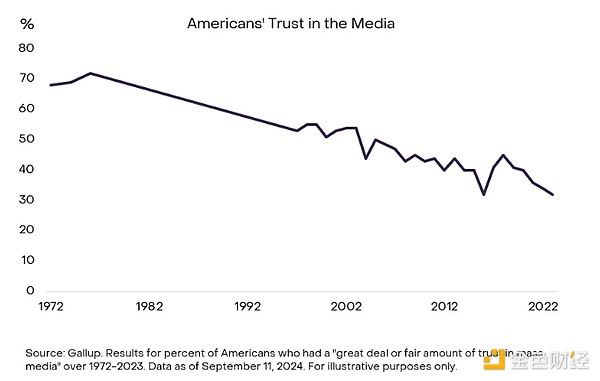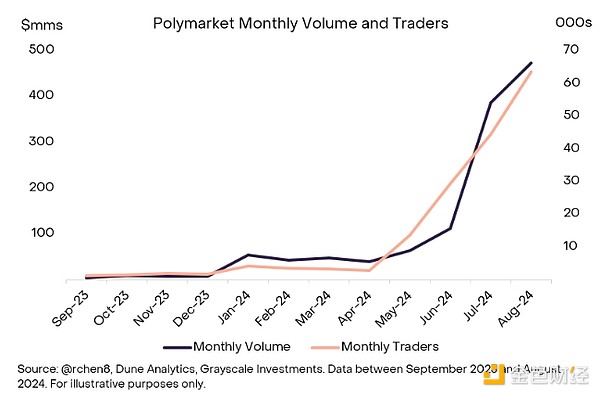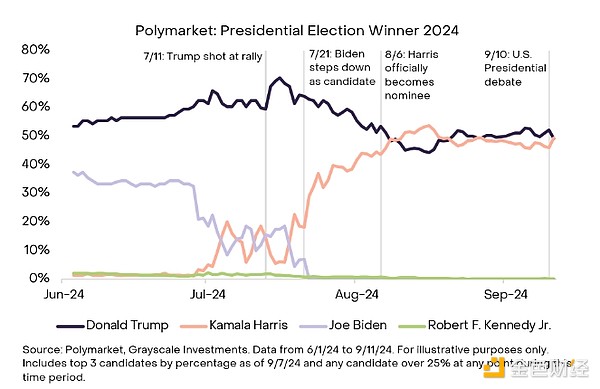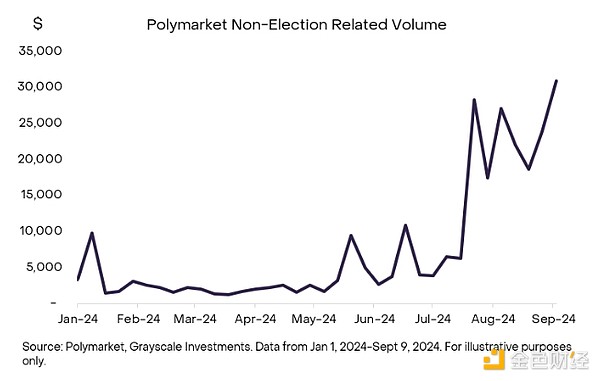Grayscale Research believes that Polymarket may become a "source of truth" by utilizing the transparency and record-keeping of blockchain technology, market incentives, and collective wisdom of users.
Source: Grayscale Research
Translation: Wuzhu, Golden Finance
Abstract
- Polymarket is a prediction market and a groundbreaking web application, which is a typical example of how blockchain technology can help improve the transparency, accessibility, and trustworthiness of markets and information.
- Polymarket allows participants to allocate funds to event contracts (e.g., who will win an election). Prediction markets provide timely and often directionally accurate probabilities for specific events, which may help investors, policymakers, and/or business leaders make decisions.
- Unlike other prediction markets, Polymarket operates on the blockchain—Polygon, which is part of the Ethereum ecosystem and a sector of the encrypted smart contract platform.
- Given the increasing distrust of the media, Grayscale Research believes that Polymarket may become a "source of truth" by utilizing the transparency and record-keeping of blockchain technology, market incentives, and the collective wisdom of users.
Decision-makers often need timely and accurate information, but according to a recent opinion poll (Figure 1), the trust of the American public in the media is currently at its lowest point in the past 50 years. In the face of increasing misinformation[1], nearly three-quarters of American adults believe that the news media is exacerbating political polarization, and nearly half of the people have little or no trust in the media's ability to report news fairly and accurately.[2]
These trends raise several questions: Is it possible to obtain truly impartial information? How can we incentivize fact-based reporting? How do we balance truth and reality, as profit-driven motives may foster biased narratives or undermine accuracy?

Figure 1: Declining trust in the media underscores the increasing importance of prediction markets
Over the past two decades, technology and financial incentives have reshaped the traditional media landscape, and decision-makers seem to be seeking alternative solutions. Grayscale Research believes that prediction markets can be part of the solution—especially those powered by blockchain technology.
Polymarket is a blockchain-based prediction market[3], which has become a major source of the 2024 U.S. presidential election probabilities in this cycle. The platform's adoption has grown rapidly (see Figure 2), gaining credibility in mainstream media, and its presidential election market odds were recently added to Bloomberg Terminal.[4] Given the increasing distrust of the media, Grayscale Research believes that Polymarket may become a "source of truth" by utilizing the transparency and record-keeping of blockchain technology, market incentives, and the collective wisdom of users.

Figure 2: Polymarket experiences significant growth in 2024
The Power of Prediction Markets
Prediction markets (or information markets) are platforms where participants can buy and sell shares representing predictions of future event outcomes. These contracts can involve almost any topic, such as politics, sports, popular culture, science, or macroeconomics. Prediction markets typically offer binary options for specific outcomes (e.g., "yes" or "no"). For example, participants may bet on whether a candidate will win an election. If the likelihood of a candidate winning increases, the value of the "yes" shares will increase, while if the likelihood decreases, the value of the "no" shares will increase.
These dynamics create market-driven probabilities of given events occurring, reflecting the collective wisdom of participants.
After the event results are announced, the market processes the outcomes, and participants who bet correctly receive rewards, while those who bet incorrectly lose their invested funds. Regardless of personal biases, participants are economically incentivized to provide accurate predictions, as correct predictions lead to profits, while incorrect predictions result in losses.
Prediction markets originated from early political betting, dating back to as early as 1503, with records of bets on the next papal election.[5] By 1884, election betting became a significant activity on Wall Street, but with the advent of modern opinion polling in the early 20th century, this activity gradually declined.[6] In the past few decades, modern prediction markets have emerged, including traditional platforms like PredictIt and Kalshi, as well as blockchain-based platforms like Augur and Polymarket.
Prediction markets are initially based on Friedrich Hayek's 1945 concept of price signals, which effectively aggregate information and often outperform traditional forecasting methods.[7] While concerns about manipulation exist, these markets typically self-correct, and historically, given the economic incentives, they have maintained fairness.
Despite the effectiveness of these prediction markets, they also carry risks; event-based contracts have recently faced regulatory scrutiny from the U.S. Commodity Futures Trading Commission (CFTC), which has proposed banning contracts predicting political outcomes on the grounds of public interest (for more information on economic theory, history, and regulation, please refer to the appendix).[8]
Polymarket Takes Flight
Polymarket is one of the first prediction markets to gain widespread adoption in modern society, whether centralized or decentralized. In the 2024 election cycle, Polymarket's trading volume has grown from $73 million in 2023 to $1.37 billion as of 2024 (Figure 2). Additionally, the platform has become a data source utilized by media reporters from publications such as The Wall Street Journal, CNN, and Bloomberg to provide thoughtful analysis and assess public sentiment on current and sometimes controversial topics. The platform's website traffic has also seen a significant increase, growing from 1.4 million visits in June 2024 to 13.8 million visits in August 2024.[9]
This year's U.S. presidential election has fueled interest in Polymarket, driven by highly unpredictable scenarios such as Trump being assassinated or Biden dropping out and supporting Harris (Figure 3). As shown below, the market for the winner of the U.S. presidential election on the platform reflects political odds fluctuations based on these events. This specific market has absorbed the largest liquidity on the platform, with a trading volume of $776 million as of September 4th.[10]

Figure 3: The market for the winner of the U.S. presidential election has attracted the strongest trading activity
In addition to increased trading volume and liquidity as attention to the November U.S. election grows, Polymarket recently invited renowned statistician and journalist Nate Silver to join the team as an advisor and announced a funding round with investors including Ethereum co-founder Vitalik Buterin and Peter Thiel's Founders Fund.[11]
How Polymarket Benefits from Blockchain Technology
Polymarket is an application on the Polygon blockchain, part of the Ethereum ecosystem, and a component of Grayscale's encrypted smart contract platform. Blockchain technology provides Polymarket with many advantages.
Polymarket combines smart contracts and decentralized decision-making to resolve contracts. These services are provided by the UMA protocol, which is a cryptographic oracle (see Grayscale glossary). UMA records each event-based contract and its on-chain resolution. In case of disputes, UMA facilitates resolution through community voting—all of which is also recorded on-chain. This mechanism helps ensure that market disputes are resolved without being subject to centralized, arbitrary, or potential biases.
Additionally, blockchain provides payment channels, enabling 24/7 global accessibility. This allows almost anyone in the world to access the Polymarket platform with low barriers and costs—unlike many centralized or Web 2.0 applications.
A Persistent Platform
Polymarket has reached new levels of coverage with its frequent news citations and a large following (see Figure 4). Today, its liquidity advantage and network effects theoretically create a more efficient market than competing platforms. Grayscale Research believes that this provides Polymarket with a significant moat, making it more attractive to potential users.

Figure 4: Polymarket leads in most key metrics compared to prediction market competitors
While Polymarket primarily relies on election-related trading volume, there has been an increase in trading volume for other content recently (Figure 5), partly due to interest in the 2024 Olympics. As of September 7, 2024, five of the top ten markets by trading volume are unrelated to elections, including Super Bowl odds, Fed rate cuts, and the highest-grossing movie in 2024.[12]
Nevertheless, election-related contracts still account for the majority of activity, including over 70% of total trading volume weekly since June.[13] Therefore, Polymarket has the potential to maximize interest in its platform during the two-month window before the U.S. election. After the election, we believe Polymarket has a significant opportunity to expand its trading volume into new areas such as sports, popular culture, and science, leveraging its growing content coverage and current position as the preferred prediction market. This will be crucial if the platform aims to continue growing after the November election.

Figure 5: Non-election-related trading volume on Polymarket has increased since July 2024
Risks and Considerations
Polymarket faces certain risks, especially in terms of regulation. In 2022, Polymarket was fined by the CFTC for offering markets without proper registration. Since 2022, the platform seems to be taking cautious measures, but the regulatory status of prediction markets remains uncertain due to the 2024 CFTC proposal to ban election-related event outcomes. Additionally, recent activity and enthusiasm may gradually diminish once the election is over.
Conclusion
Polymarket has become one of the best examples of use cases adopted in the organically growing crypto ecosystem. Currently, there are no token or airdrop-driven activities—only a product with features that resonate with users.
At a time when many crypto applications are considered too confusing or technical for non-native crypto users, Polymarket stands out by providing a clear purpose and an intuitive, familiar user experience. It is also able to do what most crypto applications cannot—gain attention and mainstream credibility from traditional institutions and media.
It is noteworthy that Polymarket prioritizes technology and product over tokens and commercialization, allowing users and media to recognize its value without needing to know that blockchain technology is used on the backend.
The Grayscale Research team has previously written about how the 2024 U.S. election has become a "crypto election," with crypto increasingly becoming a relevant issue in the campaign. The attention to crypto applications, especially against the backdrop of declining media trust and increasing polarization, highlights the potential role of Polymarket—more broadly, the role of blockchain technology—in providing a reliable, transparent alternative in the noise to seek the truth.
Appendix
- History: Early modern prediction markets include historical projects such as the Iowa Electronic Markets, DARPA's Policy Analysis Market, and game currency platforms like HSX.com. In the past decade, several new companies have emerged, including PredictIt under the Victoria University of Wellington in 2014. In 2018, the CFTC-regulated centralized prediction market Kalshi was established, while Augur became the first decentralized prediction market on Ethereum. In 2020, Polymarket was launched on the Polygon blockchain.
- Economic Theory: The economic theory behind prediction markets stems from Friedrich Hayek's concept of price signals, which effectively aggregate and disseminate information in the economy.[14] Robert Shiller's research on macro markets such as TIPS and GDP warrants demonstrates how financial instruments hedge economic risks and capture collective expectations, similar to the role of prediction markets in forecasting outcomes. Research shows that prediction markets are highly accurate, often surpassing traditional forecasting methods due to their ability to aggregate diverse information.[15] Concerns about manipulation (e.g., candidates betting on themselves) are often exaggerated, as these markets can quickly self-correct.[16] Additionally, prediction markets are typically unbiased, capturing collective beliefs without significant influence from individual behavior.[17]
- Regulation: Event-based contracts have historically been regulated by the CFTC, which prohibits contracts involving "illicit activities" or activities that "violate the public interest." In 2024, the CFTC proposed a rule to ban contracts involving political outcomes, attempting to classify them as contracts "violating the public interest."[18]
- Operation: Here is a brief overview of the components of Polymarket:
- Conditional Token Framework (CTF): Polymarket uses Gnosis' CTF to tokenize binary outcome tokens on the Polygon network as ERC1155 tokens. This allows splitting collateral into outcome tokens and merging them after resolution.
- Hybrid Order Book Model: Polymarket uses a hybrid decentralized order book model, also known as a Central Limit Order Book (CLOB). This model involves operators providing off-chain matching and order services, while settlement and execution of trades occur on-chain in a non-custodial manner. This setup also includes the option to trade using automated market makers (AMMs).
- Decentralized Oracle (UMA): Polymarket primarily utilizes UMA's Optimistic Oracle to resolve market issues (Pyth is also used for certain markets). If there is a dispute over the outcome of a specific event, UMA token holders vote to determine the correct outcome.
- Audit Proposals: The Polymarket team is currently responsible for auditing new activity-related proposals, acting as necessary centralized participants to ensure the wording of activity contracts is correct.
- USDC Markets: The markets primarily use USDC as the underlying collateral. This stablecoin-based approach simplifies trading and provides market participants with a stable value medium.
- Polygon Settlement Layer: The settlement of trades and market resolutions on Polymarket occurs on-chain on the Polygon network.
Currently, Polymarket charges a small fee (2%) from winning bets, but does not take this fee as revenue, instead rewarding liquidity providers. Additionally, a small portion of this fee is used to pay for transaction fees on the Polygon blockchain. Users also need to pay a small gas fee when depositing and withdrawing. The founders of Polygon have also hinted at the possibility of adding additional fees in the future.[19] To date, Polymarket has subsidized part of the growth of its market makers on the platform, paying out over $3 million in USDC rewards to liquidity providers to increase liquidity depth.[20]
References
[1] The Economist
[2] AP News as of May 2023
[3] Prediction markets (or information markets) are platforms where participants can buy and sell shares representing predictions of future event outcomes.
[4] In this election cycle, Polymarket has gained significant traction, with trading volume growing to XX as of 2024 and being widely cited by media outlets such as The Wall Street Journal, CNN, and Bloomberg.
[5] Rhode, Strumpf. “The Long History of Political Betting Markets.”
[6] Rhode, Strumpf. “The Long History of Political Betting Markets.” Prediction markets have evolved from early political betting to modern platforms, such as PredictIt launched by Victoria University of Wellington in 2014. In 2018, the CFTC-regulated centralized prediction market Kalshi was established, while Augur became the first decentralized prediction market on Ethereum. In 2020, Polymarket was launched on the Polygon blockchain, adding new content to a diverse landscape that includes historical projects like the Iowa Electronic Markets, DARPA Policy Analysis Market, and game currency platforms like HSX.com.
[7] Hayek. “The Use of Knowledge in Society.”
[8] “Statement on Prediction Markets”, Kenneth Arrow, 2007.
[9] Similar Web
[10] Polymarket
[11] The Block
[12] Polymarket
[13] Dune Analytics
[14] Hayek. “The Use of Knowledge in Society.”
[15] Wolfers, 2004
[16] Snowberg, 2012
[17] Berg, 2018
[18] cftc.gov
[19] Cointelegraph
[20] Messari
免责声明:本文章仅代表作者个人观点,不代表本平台的立场和观点。本文章仅供信息分享,不构成对任何人的任何投资建议。用户与作者之间的任何争议,与本平台无关。如网页中刊载的文章或图片涉及侵权,请提供相关的权利证明和身份证明发送邮件到support@aicoin.com,本平台相关工作人员将会进行核查。




